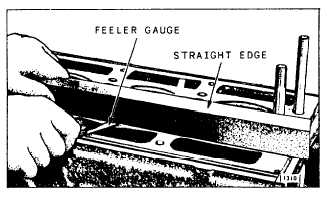CHAPTER 3
INTERNAL COMBUSTION ENGINES
This chapter is designed to help you understand the
maintenance and repair of internal combustion engines.
You as an EN2 should be able to describe the basic
procedures used to test and repair diesel engines. Also,
you should be able to identify the procedures used to
troubleshoot diesel and gasoline engines. This chapter
will cover the general procedures used to repair and
overhaul gasoline engines; the procedures used to
inspect, test, and repair jacking gear; and the procedures
used to troubleshoot and repair fuel and oil purifiers.
To help ensure that an engine will operate
efficiently, you must follow its preventive maintenance
schedule. By following the preventive maintenance
schedule, you will reduce engine casualties and help the
engine achieve its normal number of operating hours
between overhaul periods.
When you must finally perform an engine repair or
overhaul, take the following precautions:
l Plan the work in definite steps, so you can
perform it smoothly.
l Have the necessary tools and parts on hand
before you begin a repair or overhaul.
l Have the necessary forms ready to record the
clearances, dimensions, and other vital measurement
readings that must be kept as part of the engine’s history.
l Always check precision measuring instruments
before you use them; then recheck your readings. The
first reading may not be correct.
l Keep the work area clean. Do not allow oil to
accumulate on the deck or on the tools. Place the tools
or parts neatly away from the immediate area.
The test, maintenance, and repair procedures
presented in this chapter are general in nature. The
specific procedures vary with different engines. Before
you begin a maintenance or repair procedure, consult
the manufacturer’s technical manual or the equipment’s
preventive maintenance schedules. They are valuable
sources of information on tests, maintenance, and
repairs.
INSPECTING AND TESTING THE
ENGINE FRAME OR BLOCK
Before you begin an inspection or test, make sure
the outside of the engine is cleaned thoroughly. This will
help you spot cracks, leaks, and other problems more
easily than if the engine is dirty. By cleaning the engine,
you will also help prevent dirt and other contaminants
from entering and damaging parts and accessories of the
engine.
Some of the inspections and tests you may perform
are listed in the following sections.
VISUAL INSPECTIONS
Inspect the top surface of the cylinder block, the top
and bottom crankcase flanges, and the oil pan for
warpage. You can use a straightedge, a feeler gauge, and
a good light. Figure 3-1 illustrates how to use a
straightedge and a feeler gauge to check the top surface
of the cylinder block Compare your measurements to
the manufacturer’s specifications to determine if the
surface is warped.
Visually inspect the cylinder block for cracks,
breaks, or other damage.
MEASUREMENTS
Visually inspect the engine block’s bolts to
determine if they are bent, broken, or worn.
Figure 3-1.—Checking the top surface of a typical cylinder block.
3-1

